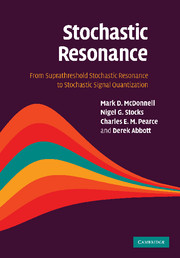Book contents
- Frontmatter
- Contents
- List of figures
- List of tables
- Preface
- Foreword
- Acknowledgments
- 1 Introduction and motivation
- 2 Stochastic resonance: its definition, history, and debates
- 3 Stochastic quantization
- 4 Suprathreshold stochastic resonance: encoding
- 5 Suprathreshold stochastic resonance: large N encoding
- 6 Suprathreshold stochastic resonance: decoding
- 7 Suprathreshold stochastic resonance: large N decoding
- 8 Optimal stochastic quantization
- 9 SSR, neural coding, and performance tradeoffs
- 10 Stochastic resonance in the auditory system
- 11 The future of stochastic resonance and suprathreshold stochastic resonance
- Appendix 1 Suprathreshold stochastic resonance
- Appendix 2 Large N suprathreshold stochastic resonance
- Appendix 3 Suprathreshold stochastic resonance decoding
- References
- List of abbreviations
- Index
- Biographies
11 - The future of stochastic resonance and suprathreshold stochastic resonance
Published online by Cambridge University Press: 23 October 2009
- Frontmatter
- Contents
- List of figures
- List of tables
- Preface
- Foreword
- Acknowledgments
- 1 Introduction and motivation
- 2 Stochastic resonance: its definition, history, and debates
- 3 Stochastic quantization
- 4 Suprathreshold stochastic resonance: encoding
- 5 Suprathreshold stochastic resonance: large N encoding
- 6 Suprathreshold stochastic resonance: decoding
- 7 Suprathreshold stochastic resonance: large N decoding
- 8 Optimal stochastic quantization
- 9 SSR, neural coding, and performance tradeoffs
- 10 Stochastic resonance in the auditory system
- 11 The future of stochastic resonance and suprathreshold stochastic resonance
- Appendix 1 Suprathreshold stochastic resonance
- Appendix 2 Large N suprathreshold stochastic resonance
- Appendix 3 Suprathreshold stochastic resonance decoding
- References
- List of abbreviations
- Index
- Biographies
Summary
To conclude this book, we summarize our main results and conclusions, before briefly speculating on the most promising areas for future research.
Putting it all together
Stochastic resonance
Chapter 2 presents a historical review and elucidation of the major epochs in the history of stochastic resonance (SR) research, and discussion of the evolution of the term ‘stochastic resonance’. A list of the main controversies and debates associated with the field is given.
Chapter 2 also demonstrates qualitatively that SR can actually occur in a single threshold device, where the threshold is set to the signal mean. Although SR cannot occur in the conventional signal-to-noise ratio (SNR) measure in this situation, if ensemble averaging is allowed, then the presence of an optimal noise level can decrease distortion.
Furthermore, Chapter 2 contains a discussion and critique of the use of SNR measures to quantify SR, the debate about SNR gains due to SR, and the relationship between SNRs and information theory.
Suprathreshold stochastic resonance
Chapter 4 provides an up-to-date literature review of previous work on suprathreshold stochastic resonance (SSR). It also gives numerical results, showing SSR occurring for a number of matched and mixed signal and noise distributions not previously considered. A generic change of variable in the equations used to determine the mutual information through the SSR model is introduced. This change of variable results in a probability density function (PDF) that describes the average transfer function of the SSR model.
- Type
- Chapter
- Information
- Stochastic ResonanceFrom Suprathreshold Stochastic Resonance to Stochastic Signal Quantization, pp. 358 - 361Publisher: Cambridge University PressPrint publication year: 2008



